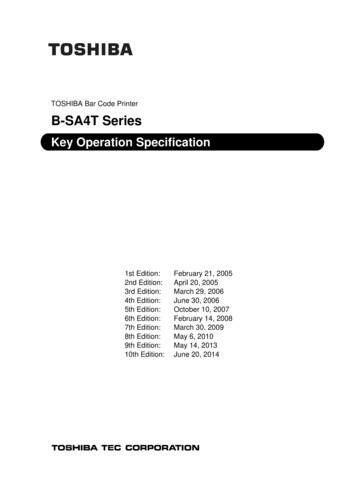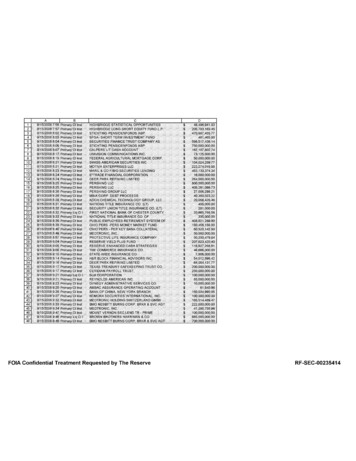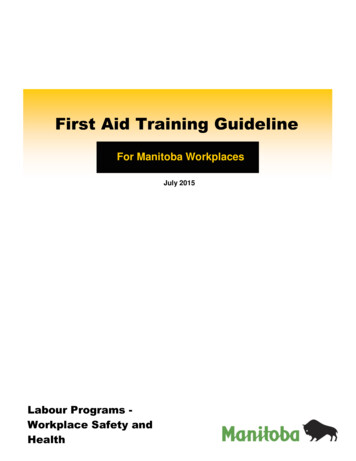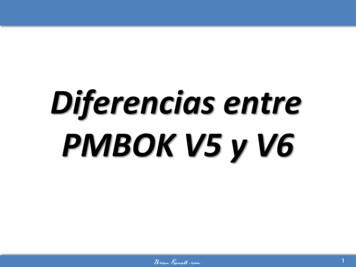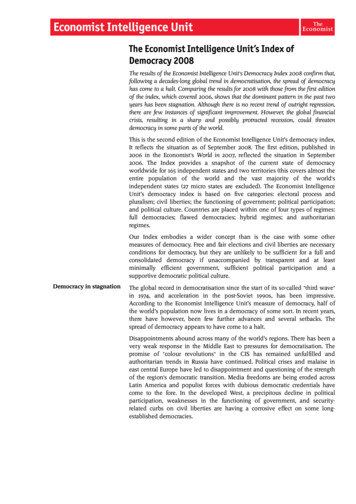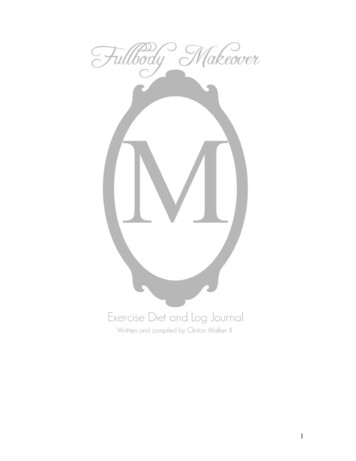
Transcription
1
First Edition 2008Published by lulu.comPrinted in the USAWritten and compiled by Clinton Walker IIICopyright Clinton Walker III 2008All rights reserved. No part of this publication may be reproduced, stored in aretrieval system or transmitted in any form or by any mean, electronic,mechanical or otherwise without the written permission of the Publisher.ISBN: 978-1-4357-0859-4Printed in the USA by Lulu press2
CONTENTSCHAPTER 1 . 6HOW CALORIES ARE BURNED . 6DETERMINING THE AMOUNT OF CALORIES YOUR BODY BURNS WHILE AT REST. 7HARRIS BENEDICT EQUATION. 7EXAMPLE 1 . 9CALORIES BURNED NEEDED TO LOSE WEIGHT . 11CHAPTER 2 . 12HOW TO SPEED YOUR METABOLISM. 12WHY SHOULD YOU EAT SIX MEALS?. 12CHAPTER 3 . 14DIET TIPS . 14TYPES OF FAT . 15EXAMPLES . 15HOW TO PLAN A DIET. 18HERE ARE SOME IMPORTANT TIPS TO CUT FAT . 21NUTRITION FACTS . 23CHAPTER 4 . 28PUTTING AN EXERCISE PROGRAM TOGETHER. 28FLEXIBILITY AND STRETCHING . 32CHAPTER 5 . 35HOW TO MEASURE PROGRESS. 35CONCLUSION. 82STEPS TO A BETTER BODY. 82TAKE A LOOK AT YOUR CURRENT DIET AND START MAKING CHANGES . 82Stop making excuses . 833
ABOUT THE AUTHORI am a 33 year-old personal trainer from Birmingham, AL. My experience includes overeight years of Personal Training. I have studied diet techniques, weightlifting, andnutrition for over 10 years. This includes the study of kinesiology at the University ofAlabama. Through extensive research, experience, and testing, I decided to put theknowledge that I gained in writing. I believe in not only training, but educating myclients to maintain their results throughout life. With the right combination of weighttraining and dieting you can achieve a healthier and better-looking body.4
INTRODUCTIONHealth and fitness are two of the most important issues facing people today. Morepeople are realizing the amazing benefits of practicing a healthier lifestyle. Manyindividuals are not willing to make the sacrifices necessary to achieve the desired goals.People are willing to try gimmick diets, pills, and even plastic surgery to get in shape.Although some of these techniques may provide a quick fix, they usually do notcontribute to long-term health. In general, people have the desire to look and feel betterphysically but lack the self-discipline to do so. A little guidance is needed to motivatepeople into taking that first step. To achieve total Health and fitness, consistency is one ofthe keys to success. With the right combination of weight training and dieting, you canachieve a healthier and better-looking body. This book will allow you to email questions,comments, and request your own personalized workout. I only give good healthy advicethat will ensure you the best short and long-term results. As a personal trainer, my rolewill be to keep you motivated to continue to workout and choose it as a lifestyle and notjust a quick fix. Although the dedication and self-discipline needed to adhere to a newfitness lifestyle is tough to accept at first, once you see the results you will want toembrace the fitness way of life. We do not believe in gimmicks, only good advice. Acombination of weightlifting, cardio activity, and dieting will get you the results you arelooking for. This book is short and too the point. This book gives you just theinformation you need to achieve your goals. If you do not understand any concepts, youmay email me for answers.Email me at fullbodymakeover@yahoo.com with your questions and goals. You mayalso check out the website at http://www.makeoverfitness.com Please allow 24 hoursfor a response. Emails are checked daily.5
CHAPTER 1How calories are burnedMany individuals labor under a misconception of how calories are burned. Theimportance of knowing how calories are burned is very significant in the fight to stayhealthy and in shape. Expend more calories than you consume and there will be weightloss. The body burns calories three ways; resting metabolic rate (RMR), energyexpended with exertions either from exercise or daily activities, and the thermiceffect of food.Resting metabolic rate is the most important of the three.1. Resting metabolic rate accounts for 60-75% of daily calories burned. This meansyou burn the most calories while at rest. The faster your metabolic rate the more caloriesyou burn. People with a high percentage of lean body mass (fat free mass) burn morecalories while at rest. This means it is important to not only lose fat but to gain muscle inthe process. It is also important to eat enough calories during the day. Restrictingcalories will lower your Metabolism rate; this is why it is important to have a goodhealthy diet plan.2. Energy expended with exercise or daily activities account for 20-30% of your dailycaloric output. You can determine the amount of calories you burn according to yourworkout and intensity. A typical exercise session will burn about 300 calories. It isimportant to do some type of exercising because daily activities alone may not burnenough calories.3. Thermic effect of food accounts for about 10% of calorie expenditure. If you eat a400-calorie meal, about 40 calories are used for digestion and absorption. This is anotherreason it is important to eat enough calories throughout the day. 10% of your caloriesburned actually come from eating.6
Determining the Amount of Calories your body burns while at rest.HARRIS BENEDICT EQUATIONThe Harris Benedict Equation is a formula that uses your BMR (calories burned whileresting) and then applies an activity factor to determine your total daily energyexpenditure (calories). The only factor omitted by the Harris Benedict Equation is leanbody mass. Remember, leaner bodies need more calories than less lean ones. Therefore,this equation will be very accurate in all but the very muscular (will under-estimatecalorie needs) and the very obese (will over-estimate calorie needs).7
English BMR FormulaWomen: BMR 655 ( 4.35 x weight in pounds ) ( 4.7 x height ininches ) - ( 4.7 x age in years )Men: BMR 66 ( 6.23 x weight in pounds ) ( 12.7 x height ininches ) - ( 6.8 x age in year )Metric BMR FormulaWomen: BMR 655 ( 9.6 x weight in kilos ) ( 1.8 x height in cm ) - ( 4.7 x age in years)Men: BMR 66 ( 13.7 x weight in kilos ) ( 5 x height in cm ) - ( 6.8 x age in years )STEP 1Plug in the appropriate numbers and solve the formula above to find your BMR(Basal Metabolic Rate)STEP 2After you determine the BMR (Basal Metabolic Rate) choose the appropriatecategory from the chart.Harris Benedict FormulaTo determine your total daily calorie needs, multiply your BMR by the appropriateactivity factor, as follows:1. If you are sedentary (little or no exercise): Calorie-Calculation BMR x 1.22. If you are lightly active (light exercise/sports 1-3 days/week): Calorie-Calculation BMR x 1.3753. If you are moderately active (moderate exercise/sports 3-5 days/week): CalorieCalculation BMR x 1.554.If you are very active (hard exercise/sports 6-7 days a week): Calorie-Calculation BMR x 1.7255.If you are extra active (very hard exercise/sports & physical job or 2x training):Calorie-Calculation BMR x 1.9STEP 3After you choose the appropriate category, multiply your BMR times the propernumber. The answer will give you an estimate of your calories burned at rest.8
EXAMPLE 1DETERMINE THE RESTING METABOLISM (AMOUNT OFCALORIES BURNED DURING REST) FOR SUSANSusan is 45 years old; she weighs 245 pounds and is 5 foot 5 inches tall. Sheworks the type of job where she sits for most of the day. Susan does notexercise ever. How many calories is Susan burning while at rest?STEP 1 First, find Susan’s BMRPlug Susan’s weight, height, and age into the formulaEnglish BMR FormulaWomen: BMR 655 (4.35 x weight in pounds) (4.7 x height in inches) - (4.7 x agein years)Men: BMR 66 (6.23 x weight in pounds) (12.7 x height in inches) - (6.8 x age in year)BMR 655 (4.35 x weight in pounds) (4.7 x height in inches) – (4.7 x age inyears).BMR 655 (4.35 x 245) (4.7 x 65) – (4.7 x 45)BMR 655 1065.75 305.5 – 211.5BMR 1814.75STEP 2Determine where Susan falls on the figure 1.Since Susan sits at her desk most of the day and does not exercise she would fallunder the number 1.9
Figure 1Harris Benedict FormulaTo determine your total daily calorie needs, multiply your BMR by the appropriateactivity factor, as follows:1.If you are sedentary (little or no exercise): Calorie-Calculation BMRx 1.22.If you are lightly active (light exercise/sports 1-3 days/week): Calorie-Calculation BMR x 1.3753.If you are moderately active (moderate exercise/sports 3-5 days/week): CalorieCalculation BMR x 1.554.If you are very active (hard exercise/sports 6-7 days a week): Calorie-Calculation BMR x 1.7255.If you are extra active (very hard exercise/sports & physical job or 2x training):Calorie-Calculation BMR x 1.9STEP 3Plug numbers into the formulaThe formula for number 1 is BMR X 1.2Plug in the appropriate numbersSUSAN’S CALORIES BURNED WHILE AT REST SUSAN’S BMR X1.2SUSAN’S CALORIES BURNED WHILE AT REST 1814.75 x 1.2 2177.7ANSWER: SUSAN BURNS approximately 2177.7 CALORIES A DAY AT REST.2177.7 are the amount of Calories Susan burns at rest.If Susan decided to exercise and burn 600 calories how many TOTALcalories would she burn?10
FORMULA FOR SUSAN’S TOTAL CALORIES BURNEDSUSAN’S CALORIES BURNED RESTING AMOUNT OF CALORIES BURNEDEXERCISING.Susan burns 2177.7 calories resting. If she burns an additional 600 calories exercising Susanwould burn 2177.7 600 2877.7SUSAN’S TOTAL CALORIES BURNED ARE 2877.7If Susan wants to lose weight for that day she would have to eat less than 2877.7 calories.Calories Burned needed to lose weightThere are approximately 3500 calories in a pound of stored body fat. If you create a3500-calorie deficit through a combination of diet and exercise, you will lose onepound of body weight. (On average 75% of this is fat, 25% lean tissue) If you createa 7000-calorie deficit, you will lose two pounds and so on. The calorie deficit can beachieved either by calorie-restriction alone, or by a combination of fewer calories in(diet) and more calories out (exercise). The combination of diet and exercise is thebest method for lasting weight loss. Sustained weight loss is difficult or impossiblewithout increased regular exercise.11
CHAPTER 2How to speed your metabolismThree ways to speed up your metabolism1. Eat six smaller meals instead of three large meals.You should consume breakfast, lunch, dinner, and three snacks daily. It is best toeat your snacks between meals and after dinner. Eating snacks will help controlyour appetite throughout the day. A snack may be as small as a piece of fruit,crackers, vegetables, or peanuts. When you eat six smaller meals, you burnadditional calories daily.Many individuals use the excuse of not having the time or appetite to eat sixmeals. If you plan your meals according to your schedule, you can learn to eatproperly. You can easily consume a snack on the go even with a hectic schedule.TIP: Try to eat your last meal before 8pm.WHY SHOULD YOU EAT SIX MEALS? Eating six small meals help burn additional calories during the day.It also increases your Resting metabolism (BMR; the amount of calories youburn at rest).2. Add weightlifting to your exercise routine. You should perform a weightlifting routine at least two times a week alongwith cardiovascular exercises.Use lightweights and high reps to tone your muscles.YOU CANNOT EFFECTIVELY LOSE WEIGHT AND TONEWITHOUT SOME WEIGHTLIFTING.Many women believe weightlifting will cause them to become too muscular. Thisbelief is a common misconception. If you lift lightweights with high reps (12-15),your muscle gains will look feminine. Lifting weights will cause your body togain some muscle mass. Increased muscle mass is NESSESARY to increase yourmetabolism rate.12
3.Drink plenty of water.Continuously drinking water throughout the day is essential to your success. Youshould drink at least eight to ten glasses a day. You should consume more thanten glasses if you are active. Adequate hydration is important especially whenexercising. Lack of water may cause decreased performance, headaches, andconstant fatigue. Fluids have at least three important functions.1. Transport glucose to working muscles and carries away metabolic byproducts.2. Fluid in urine eliminates metabolic waste products.3. Fluid in sweat dissipates heat through the skin.At the end of the day, you should have consumed more water than any otherliquids.13
CHAPTER 3Diet tipsTo effectively lose weight you must eat a healthy and balanced diet. Fad diets, pills,and other gimmicks are not effective or healthy. While these products usually produceshort term results, they have more side effects than benefits.Here is a simple breakdown.Carbohydrates should be 60% of your daily diet Carbohydrates are the body’s main source of energy. You must consume enoughcarbohydrates daily to remain healthy. Restricting your calories with lowcarbohydrate diets decreases your energy.Types of CarbohydratesSimple carbohydrates like (sugars, including glucose and fructose fromfruit and vegetables, lactose from milk, and sucrose from cane or beet sugar)Complex carbohydrates like (carrots, broccoli, corn, potatoes, bread,cereal, pasta, rice, and beans) which contain glucose, fiber, and othernutrients.14
Fat should be 30% of your daily diet Fat adds flavor to food, and is an important component of a healthy diet. Fat isnecessary for energy production, transporting fat soluble vitamins, protection ofinternal organs, insulation, healthy skin, hair, and supplying the linoleic acid1.Types of fat1. Triglycerides are the chemical form in which most fat exists in food as well as in thebody. They're also present in blood plasma and, in association with cholesterol, form theplasma lipids.2. Saturated fats come primarily from animal sources:EXAMPLESButter, whole milk, dairy products, and meats.1Linoleic acid is a member of the group of essential fatty acids called omega-6 fatty acids, so called becausethey are an essential dietary requirement for all mammals.15
Coconut and palm oils are also high in saturated fat. Saturated fat raisescholesterol2 levels more than any element in your diet. Less than 10% of your dailycalories should come from saturated fat sources.3. Unsaturated fats can be either monounsaturated or polyunsaturated.Monounsaturated fats. This type of fat can reduce LDL cholesterol withoutaffecting beneficial HDL’s. This is the preferred form of fat in a diet.Examples include olive oil, canola oil, peanut oil, and avocado oil.Polyunsaturated Fats are divided into omega-6 vegetable oils and omega-3 fish oils.Examples include sunflower, corn, and sesame. The omega-3 oils comefrom fish like mackerel, halibut, salmon, albacore tuna, and whitefish.Benefits of Omega-3 oils are decreased blood pressure, cholesterol, triglycerides, and bloodclotting.2CholesterolCholesterol is a building block of cells, vitamins, and hormones in the body. The human body makes cholesterol in all cells of thebody and also gets cholesterol from some foods in the diet. It is transported in the bloodstream to other cells or for elimination by thebody.Cholesterol is a solid fat carried in blood by lipoproteins and deposited in the walls of arteries which therefore narrow and when theyblock completely cause heart attacks and strokes.16
THE PROBLEM:Most people eat almost twice as much fat as the human body is designed to handle. 36% to41% of total daily calories often come from fat.17
Protein should be 10% of your daily dietProtein builds and repairs muscle, red blood cells, hair, and other tissues. Protein is alsonecessary for the synthesizing hormones. Examples from plants include: Fruits, grains, and vegetables. Examples from legumes include: Dried beans or tofu with rice or bread. Meat is a good source of protein, but too much may lead to high cholesterol.Here are some less fatty cuts of meatBeef .Top round, eye of round, round steak, rump roast, sirloin tip,short lion, strip steak lean, lean and extra lean ground beef.Pork Tenderloin, sirloin roast or chop, center cut loin chopsLamb Foreshank, leg roast, leg chop, loin chopHOW TO PLAN A DIETSTEP 1DETERMINE YOU’RE EATING PATTERNSTake a few days to record what you are eating and drinking, being specific as possible.Logging your diet will give you an idea of what and when you are eating. Tracking your dietis important in determining the changes needed.Visit www.makeoverfitness.com and use the calorie counter to determine thebreakdown of calories for most foods. Enter the name of the food into the box and pressenter.18
Analyze your log sheet and determine how many calories you consume daily. Calorie intakeneeds will differ for each individual. Many people mistakenly eat too few calories.Consuming under 1200-calories for women and 1800-calories for men is severely low.Typically it is best to eat about 500-1000-calories less aday than your total calories burned.(See Chapter 1: Harris Benedict Equations)After you determine an estimate of your calorie intake, use the chart below to determine thebreakdown where your calories should come 1300Calories1400Calories1500Calories720 / 180 grams780 / 195 grams840 / 210 grams900 / 225 grams360 / 40 grams420 / 43 grams450 / 46 grams480 / 50 grams120 / 30 grams140 / 33 grams150 /36 grams160 / 38 grams1600Calories1700Calories1800Calories960 / 240 grams1020 / 255grams1080 / 270 grams510 / 53 grams540 / 56 grams570 /59 grams170 / 40 grams180 / 43 grams190 / 45 grams1900Calories2000Calories2100 Calories2200 Calories2300 Calories1140 / 295 grams1200 / 310 grams1260 / 325 grams1320 / 340 grams1380 / 355 grams600 / 62 grams630 / 65 grams660 / 68 grams690 / 71 grams720 /74 grams200 / 48 grams210 / 51 grams220 /54 grams230 /57 grams240 /60 gramsCalories/GramsFatProteinCalories/Grams Calories/Grams19
STEP 2PLAN AND MAKE CHANGES TO YOU’RE DIETIf you are not eating enough, increase your calorie intake. Women and men should eat atleast 1200 and 1800 calories a day respectively. Severely restricting calories willresult in an eventual weight gain or lack of energy. If you are restricting yourcalories, start eating more immediately. If you are eating too much start by cutting yourportion sizes.TIPS TO CONTROL PORTION SIZE Decrease your portions by halfYou can lose weight and still enjoy your favorite foods. Just decrease yourportion sizes by half. Take your typical dinner serving and decrease it by half.Try supplementing your meal with fresh fruit or vegetables on the side. After youeat, wait a few minutes to allow yourself to feel full. You will probably noticeyou don’t feel the urge to eat as much. Don’t eat a three-course meal at restaurantsWhen dining out, watch how much you are eating. Most restaurants serve hugeportions for the main course. Eating an appetizer, main course, and desert is toomuch food. Many restaurants offer lunch size portions of their dishes, which aresmaller than their full-size dinner entrees. In most restaurants you can purchasethe lunch size entree at dinnertime. Ordering from the lunch menu helps withportion control. Don’t biggie-size anythingFast food portions are normally too large. Upsizing meals give you extra foodyou don’t need. If you decide to eat fast food (which should be rare), order theregular size. Start Reading LabelsLook carefully at the serving size for your food. Find out how many servings youare actually consuming. You will soon know how to measure a serving sizesimply by looking at the food.20
NO BUFFETS!!!It is nearly impossible to practice portion control in an "all-you-can-eat" situation.Many individuals mistakenly eat as much as possible in a buffet. This is not goodfor someone on a diet. Learn the standards:3 oz. of meat is the size of a deck of cards or an audio tape; 1 oz. of meat is thesize of a matchbook; 1 cup of potatoes, rice, or pasta looks like a tennis ball.Here are some important tips to cut fat1. Read labels to determine both the amount and type of fats in foods.The new food labels mandated by the Food and Drug Administration for processed foods were onmost products as of July, 1994. Single ingredient foods, such as fresh fruits, vegetables, meat,poultry, fish and unprocessed grains are not required to have labels. The new labels must contain thefollowing information.Total caloriesCholesterolSugarsCalciumCalories from fatDietary fiberProteinIronTotal fatSodiumVitamin ASaturated fatTotal CarbohydratesVitamin C21
When reading labels:1. Look carefully at the serving size. If your normal serving size is more or less than the servinglisted, you’ll need to adjust when considering the amount of fat (or carbohydrates, or proteins) in theproduct.2. Look at the calories from fat. Figure the percent of calories coming from fat by dividing the totalcalories into the calories from fat. Figure the percent of calories coming from fat by dividing thetotal calories into the calories from fat (see item in red in figure 1: 36/120 30%).3. Look at the grams of fat in the food and consider how this food fits into your total daily fat gramallotment.4. The percentage (%) daily value can be confusing for some people. It measures the amount of theparticular nutrient in the food (e.g., fat) against the amount of that nutrient an average person issupposed to have in one day. So, if you consume a 2,000 calorie per day diet, 30% fat is 600 caloriesfrom fat or about 65-66 grams of fat (see bottom of Table 1). A serving of six cookies nets four gramsof fat, which is 6% of the 66 total grams of fat, your are allowed per day.5. On the bottom of each label is a little nutrition lesson.For people consuming 2,000 or 2.500 calories per day, total fat, saturated fat, cholesterol, sodium,total carbohydrate, and dietary fiber recommendations are right there. In addition, calorie valuesper gram of fat, carbohydrates, and protein are on the labels for easy reference.22
Table 1Nutrition FactsServing size 6 cookies (28g)Servings per container about 11Amount per ServingCalories 120Calories from Fat 36% Daily Value*6%4%Total Fat 4gSaturated Fat 0.5gPolyunsaturated Fat 0gMonounsaturated Fat 1gCholesterol 5mg2%Sodium 105mg4%Total Carbohydrate 20 g7%Dietary Fiber less than 1g2%Sugars 7gProtein 2gVitamin A 0%Vitamin C 0% * Calcium 0% * Iron 8%*Percent Daily Values are based on a 2,000 calorie diet.Your daily values may be higher or lower depending on your calorie needs:CaloriesTotal FatSat FatCholesterolSodiumTotal CarbohydrateDietary FiberCalories Per Gram: Fat 9 *2,0002,500Less thanLess thanLess thanLess than66g83g20g25g300g300mg2,400mg 2,400mg300g375g25g30gCarbohydrate 4 * Protein 42. Instead of red meat, sometimes opt for chicken or fish (Skinless cuts out even morefat)3. If your diet consists of large portions of meat, try to eat more meatless meals. Usevegetables, grains and legumes as the main dish.4. Select lean meats and eat smaller portions (three to five ounces). Trim off the fat.5. Limit intake of fats and oils, especially those high in saturated fat. Choose amargarine that has at least twice as much polyunsaturated fat as saturated.6. Broil, bake, or boil foods instead of frying.7. Cut back on fat-laden snack foods e.g. potato chips, cookies, and pastries.23
8. Stop Cola consumptionFor every 20 ounces of Coca-Cola you drink, you're consuming 250 calories. If you'retrying to consume around 1500-calories a day in order to lose weight, you can blow yourentire calorie budget on soda.24
SAMPLE DIET PLANTake a look at this diet plan and try to plan your meals similar to table 2.DAYMONBreakfast3 egg whites or½ cup EggBeaters(flavored withsalsa)Snack2/3 cup OJ or 1cup nonfat milk1 small mealreplacement barLunch3 oz white turkeymeat2 slices whole wheatbread½ cup soup, brothbasedSteamed veggiesSnack1 mediumpiece fruitTUES2/3 cupoatmeal ½ cupbanana slices1 cup nonfatmilk1 medium piecefruit with ¼ cuplow-fat cottagecheese3 oz tuna1 Tbsp. nonfat mayo2 slices whole wheatbreadSteamed veggies1 small branmuffinDinner1-1/2 cupspasta with ¼cut marinarasauce3oz. broiledchicken breastSteamedveggiesRomainelettuce with 1Tbsp. low-fatdressing3 oz grilled orbroiledsalmon withmarinade (2Tbsp. lite soysauce,1 Tbsp.Ginger, 1Tbsp. garlic)Steamedveggies1 cup brownrice25
WED2 waffles with 2tsp. lite syrup2/3 cup OJ1 cup low-fatyogurt2 oz ham1 oz low-fat Swisscheese2 Slices rye breadBrown mustard1oz. bakedPotato chips1 medium piece fruit½ cup frozenyogurt orsorbetTHUR1 cup oat brancereal with 1cup fruit1 cup nonfatmilk1 Tbsp. peanutbutter oralmond butterwith celery½ cup turkey chili1 oz. low-fatCheddar cheese½ sourdough roll½ cup fresh fruitSteamed veggies1 Tbsp.Peanutbutter oralmondbutter1 plain ricecakeFRI½ bagel Tbsp.low-fatCream cheese½ cup nonfatmilk or 2/3cup OJ1 cup freshfruit½ cup nutsplain peanuts,cashews,almonds, etc.)Veggie hot dogHot dog bunLight spread ofmustard/ketchup1 small baked potatowith 1 Tbsp. fat-freesour creamSteamed veggies1 smallgranola bar1oz frozenyogurt orsorbet3 oz. grilledred meat (leancut, palm size)1 small bakedpotato with 1Tbsp. fat-freesour creamSteamedveggies1 slice whole1 slice pizza(1/8 of 15 inchmediumpizza)Salad with 1Tbsp. low-fatdressing1 cup freshfruit orvegetables3 oz skinlessgrilled turkeybreast1 mediumsweet potatoSteamedveggies1 cup freshfruit¾ cup brownriceTable 2This chart gives you an idea of how you should plan your meals. Of course you do not haveto eat the exact foods on the above chart. This chart is a guide of how you should plan yourmeals.26
WHEN TO EATEating at the right times is very important to losing weight. Try not to eat 3 hours before bedtime. This technique helps your body burncalories while you’re asleep. Since you will be hungry in the morning youshould NOT miss breakfast. Breakfast is the most important meal of the dayand you should rarely miss it. Don’t eat a large meal right before a workout. A light snack such as fruit ora power bar one hour before a workout is ok. Make sure you have eatensomething a few hours before the workout so you can have enough energy. You can still enjoy some of your favorite foods in moderation. If yougradually make changes to your diet, you will achieve life-changing results.If you would like for me to take a look at your meal plan email me atfullbodymakeover@yahoo.com27
CHAPTER 4Putting an exercise program togetherA good exercise program is a combination of cardiovascular and weightliftingexercises. Your weightlifting should consist of seven to twelve exercises. Make sure tobalance your workout to include all muscle groups. For the best results, perform a fewexercises for each muscle group.A complete workout program changes slightly every couple of weeks. Performing thesame routine causes progress to decrease. Challenge your body by doing differentweightlifting and cardiovascular exercises. If you are walking two miles per hour on thetreadmill, speed up to three miles per hour. Change your exercises on each body partperiodically.YOU HAVE TO LIFT weights along with cardiovascular exercises if you desire goodresults. To speed up your metabolism you must increase muscle mass. Some type ofweightlifting should be performed at least two times a week.The first example workout is a full body workout that focuses on the entire body. Thistype of program would be performed three times a week with a day of rest in-between. Ifyou work a muscle group on one day you should rest those muscles the next day. Youmay also choose to perform upper body exercises one day and lower body the next.When performing this type of program you can lift weights on consecutive days. Thisprogram allows your upper body to rest while performing lower body exercises.28
Spot reducing- trying to lose weight in one part of yourbod
How to speed your metabolism Three ways to speed up your metabolism 1. Eat six smaller meals instead of three large meals. You should consume breakfast, lunch, dinner, an d three snacks daily. It is best to eat your snacks between meals and after dinner. Eating snacks will help c
